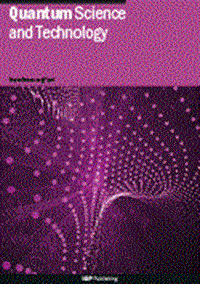通过多重保真度检测不忠实纠缠
IF 5.6
2区 物理与天体物理
Q1 PHYSICS, MULTIDISCIPLINARY
引用次数: 0
摘要
实验证明未知量子态的纠缠是量子计算和量子物理中的一个基本问题。由于易于实现,现代量子实验中最流行的方法是利用基于保真度的纠缠见证检测目标量子态。具体来说,如果目标状态与纠缠纯态之间的保真度超过一定值,则可以保证目标状态处于纠缠状态。然而,最近人们意识到存在所谓的不忠实量子态,它们可以被纠缠,但它们的纠缠不能被任何基于保真度的纠缠证人证明。在本文中,我们通过具体的例子表明,如果通过将多个保真度组合在一起对基于保真度的纠缠证人进行轻微修改,仍然可以使用这种流行的技术来证明不忠实量子态的纠缠。特别地,我们将分析改进的纠缠见证的数学结构,并提出一种算法来搜索它们的最优设计。本文章由计算机程序翻译,如有差异,请以英文原文为准。
Detecting unfaithful entanglement by multiple fidelities
Certifying entanglement for unknown quantum states experimentally is a fundamental problem in quantum computing and quantum physics. Because of being easy to implement, a most popular approach for this problem in modern quantum experiments is detecting target quantum states with fidelity-based entanglement witnesses. Specifically, if the fidelity between a target state and an entangled pure state exceeds a certain value, the target state can be guaranteed to be entangled. Recently, however, it has been realized that there exist so-called unfaithful quantum states, which can be entangled, but their entanglement cannot be certified by any fidelity-based entanglement witnesses. In this paper, by specific examples, we show that if one makes a slight modification to fidelity-based entanglement witnesses by combining multiple fidelities together, it is still possible to certify entanglement for unfaithful quantum states with this popular technique. Particularly, we will analyze the mathematical structure of the modified entanglement witnesses, and propose an algorithm that can search for the optimal designs for them.
求助全文
通过发布文献求助,成功后即可免费获取论文全文。
去求助
来源期刊

Quantum Science and Technology
Materials Science-Materials Science (miscellaneous)
CiteScore
11.20
自引率
3.00%
发文量
133
期刊介绍:
Driven by advances in technology and experimental capability, the last decade has seen the emergence of quantum technology: a new praxis for controlling the quantum world. It is now possible to engineer complex, multi-component systems that merge the once distinct fields of quantum optics and condensed matter physics.
Quantum Science and Technology is a new multidisciplinary, electronic-only journal, devoted to publishing research of the highest quality and impact covering theoretical and experimental advances in the fundamental science and application of all quantum-enabled technologies.
 求助内容:
求助内容: 应助结果提醒方式:
应助结果提醒方式:


